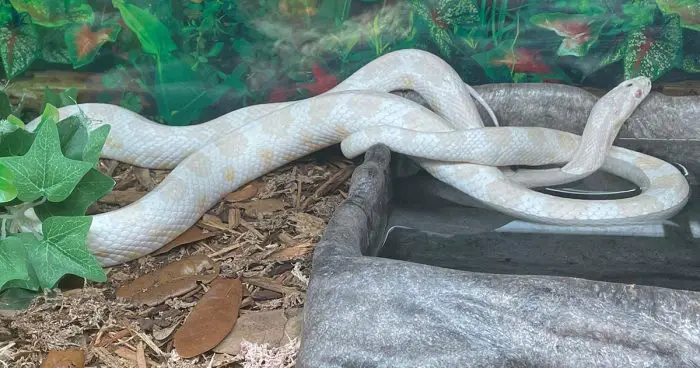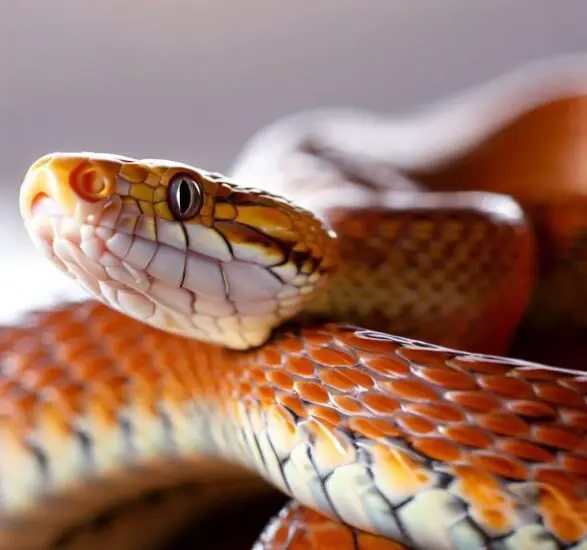
Corn snakes, scientifically known as Pantherophis guttatus, are popular pet reptiles cherished for their vibrant colors, docile nature, and relatively easy care requirements. Before welcoming a corn snake into your home, it’s essential to understand its lifespan and the factors that can influence it. In this article, we will explore the question, “How long do corn snakes live?” and provide you with valuable insights into the life expectancy of these fascinating creatures.
What is a Corn Snake?
Corn snakes are non-venomous reptiles native to the southeastern United States. They are slender in appearance and can grow to an average length of 3 to 5 feet. These snakes exhibit a remarkable range of colors, including shades of red, orange, brown, and black. Their name, “corn snake,” is derived from their presence in cornfields, where they hunt for prey such as small rodents.
Factors Affecting Lifespan
The lifespan of a corn snake can be influenced by various factors, including genetics, diet, habitat, environmental conditions, stress levels, and overall care provided by its owners. Understanding these factors is crucial for ensuring the longevity and well-being of your pet corn snake.
Average Lifespan of a Corn Snake
On average, corn snakes have a lifespan of 15 to 20 years when provided with proper care. However, it’s important to note that some corn snakes have been known to live even longer, reaching ages of 25 years or more. Providing optimal conditions and meeting their specific needs can contribute to their longevity.
 How Long Do Corn Snakes Live
How Long Do Corn Snakes Live
Longevity Tips for Corn Snakes
To help your corn snake live a long and healthy life, consider the following tips:
- Provide a spacious and appropriately sized enclosure.
- Maintain suitable temperature and humidity levels.
- Offer a varied and balanced diet consisting of appropriately sized prey.
- Ensure access to clean water at all times.
- Regularly clean the enclosure to prevent the buildup of waste and bacteria.
- Minimize stress by handling your corn snake gently and avoiding sudden loud noises or disturbances.
Signs of a Healthy Corn Snake
Monitoring the health of your corn snake is crucial for early detection of any potential issues. Look out for the following signs of a healthy corn snake:
- Active and alert behavior
- Clear and bright eyes
- Sheds skin in one complete piece
- Healthy weight and body condition
- Consistent eating and digestion patterns
Common Health Issues
While corn snakes are generally hardy reptiles, they can be susceptible to certain health issues. Some common health problems in corn snakes include:
- Respiratory infections
- Parasites
- Mouth rot
- Scale infections
Proper Diet and Nutrition
Maintaining a well-balanced diet is essential for the overall health and longevity of your corn snake. In the wild, corn snakes primarily feed on small rodents, such as mice and rats. As a pet owner, it is your responsibility to provide a diet that mimics their natural food sources.
Offering appropriately sized prey items is crucial. For young corn snakes, start with pinky mice and gradually increase their size as they grow. Adult corn snakes can be fed adult mice or even small rats. It’s important to ensure that the prey item is no wider than the snake’s body to prevent any digestion issues.
Feeding your corn snake frozen and thawed prey is highly recommended, as it eliminates the risk of injury to your pet and reduces the chance of introducing parasites. Remember to always thaw the prey item thoroughly and use tongs to offer it to your snake. Feed your corn snake once every 5 to 7 days, adjusting the frequency based on its age and size.
 How Long Do Corn Snakes Live
How Long Do Corn Snakes Live
Enclosure and Habitat Requirements
Creating a suitable enclosure is vital for the well-being of your corn snake. A properly sized enclosure will provide security, comfort, and opportunities for natural behaviors. A 20-gallon tank is suitable for young corn snakes, but as they grow, a larger enclosure will be required. A 40-gallon tank or equivalent-sized enclosure is ideal for adult corn snakes.
Ensure that the enclosure has a secure lid to prevent any escape attempts. Use a substrate that allows for burrowing and retains humidity, such as aspen bedding or cypress mulch. Provide hiding spots on both the warm and cool sides of the enclosure to allow your snake to regulate its body temperature.
Maintain a temperature gradient within the enclosure, with a warm side ranging from 85 to 90°F (29 to 32°C) and a cool side around 75 to 80°F (24 to 27°C). Use a thermostat to regulate the heat source and prevent overheating. Additionally, maintain a humidity level of 40% to 60% by misting the enclosure and using a water bowl.
Handling and Socialization
Corn snakes are generally docile and can tolerate handling well. However, it’s essential to approach them with care and respect their boundaries. Give your corn snake time to acclimate to its new environment before attempting to handle it.
When handling your snake, support its body fully to prevent it from feeling insecure or stressed. Avoid sudden movements or loud noises that may startle the snake. Start with short handling sessions and gradually increase the duration as your corn snake becomes more comfortable.
Remember that not all corn snakes enjoy frequent handling, and some may be more reclusive by nature. Always observe your snake’s behavior and adjust your handling routine accordingly.
Environmental Enrichment
Providing environmental enrichment is crucial for keeping your corn snake mentally stimulated and promoting natural behaviors. Offer a variety of climbing branches, artificial plants, and hideouts to create an engaging and enriching environment.
Introducing different textures and objects for your snake to explore can be beneficial. For example, you can place rocks or logs in the enclosure to create hiding spots or surfaces for shedding.
Monitoring and Regular Check-ups
Monitoring your corn snake’s health is essential for early detection of any potential issues. Regularly observe your snake for any changes in behavior, appetite, or physical appearance.
It is recommended to establish a relationship with a reptile veterinarian who can provide routine check-ups and address any health concerns. Regular veterinary visits are crucial for maintaining the well-being of your corn snake and ensuring its longevity.
 How Long Do Corn Snakes Live
How Long Do Corn Snakes Live
Breeding and Reproduction
Breeding corn snakes can be a rewarding experience for reptile enthusiasts. However, it requires careful planning and knowledge of their reproductive process. Breeding typically occurs during the cooler months, as corn snakes go through a brumation period where their activity and metabolism slow down.
To breed corn snakes, you’ll need a male and a female of breeding age. Ensure that both snakes are healthy and in optimal condition before introducing them. Provide a separate mating enclosure with suitable hiding spots and a temperature gradient.
The female corn snake will lay a clutch of eggs, typically ranging from 10 to 30 eggs, depending on her size and age. These eggs should be carefully incubated at a temperature of around 82 to 86°F (28 to 30°C) until they hatch. It’s important to maintain proper humidity levels during the incubation period to prevent the eggs from drying out.
Genetic Factors and Morphs
Corn snakes exhibit a wide range of color and pattern variations, known as morphs. These morphs result from different genetic factors and selective breeding. From classic “normal” corn snakes to stunning morphs like Amel, angry, and Snow, there is a vast array of options for reptile enthusiasts.
If you are interested in specific morphs, it’s essential to research the genetic inheritance patterns associated with them. Understanding genetics will help you make informed breeding decisions and produce desirable offspring.
Impact of Stress on Lifespan
Stress can have a significant impact on the lifespan and overall health of corn snakes. Avoid subjecting your snake to unnecessary stressors, such as sudden changes in environment, loud noises, or handling when it is not receptive.
Creating a calm and consistent environment for your corn snake will help minimize stress and contribute to its longevity. Remember to provide ample hiding spots, maintain appropriate temperatures, and handle your snake gently and infrequently.
Conclusion (How Long Do Corn Snakes Live)
In conclusion, corn snakes are captivating reptiles with an average lifespan of 15 to 20 years when provided with proper care. By understanding their specific needs, including diet, habitat, and handling, you can ensure the well-being and longevity of your pet corn snake.
Remember to maintain a balanced diet, create a suitable enclosure, monitor their health regularly, and provide environmental enrichment. By following these guidelines and offering a stress-free environment, you can enjoy the companionship of your corn snake for many years to come.
FAQs (How Long Do Corn Snakes Live)
Corn snakes should be fed once every 5 to 7 days, adjusting the frequency based on their age and size.
It is generally not recommended to house corn snakes together, as they can become territorial and may exhibit aggressive behavior towards each other.
Occasional refusal to eat is not uncommon. Ensure that the husbandry conditions are appropriate and monitor their health. If the refusal persists, consult a reptile veterinarian for further guidance.
